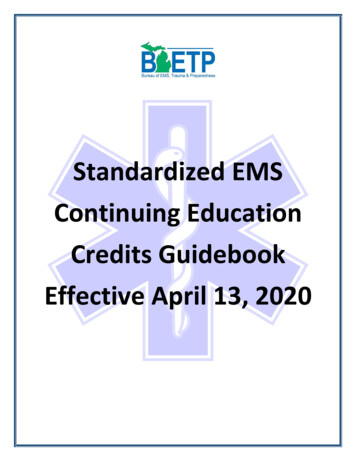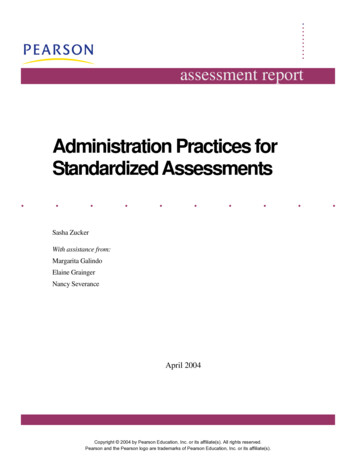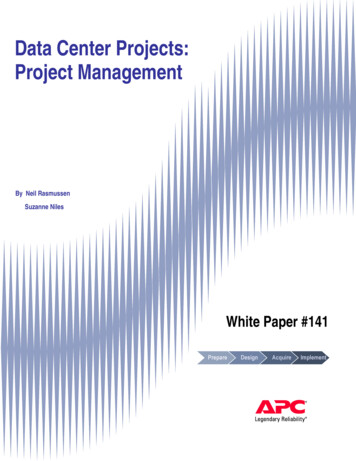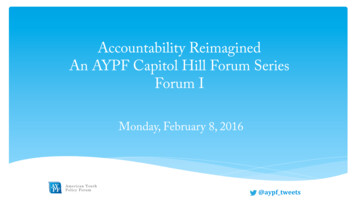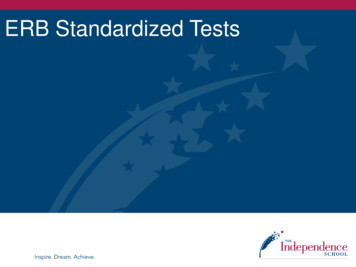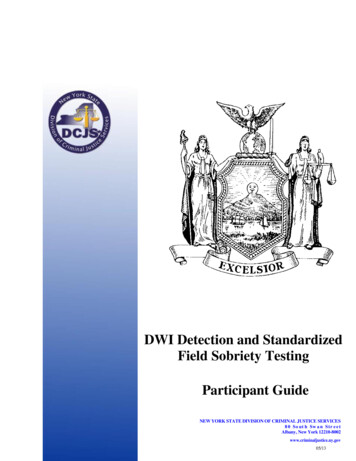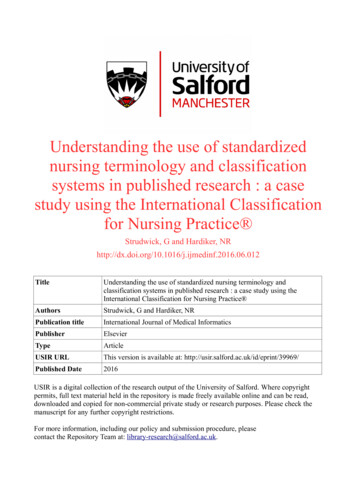
Transcription
Understanding the use of standardizednursing terminology and classificationsystems in published research : a casestudy using the International Classificationfor Nursing Practice Strudwick, G and Hardiker, TitleUnderstanding the use of standardized nursing terminology andclassification systems in published research : a case study using theInternational Classification for Nursing Practice AuthorsStrudwick, G and Hardiker, NRPublication titleInternational Journal of Medical InformaticsPublisherElsevierTypeArticleUSIR URLThis version is available at: d Date2016USIR is a digital collection of the research output of the University of Salford. Where copyrightpermits, full text material held in the repository is made freely available online and can be read,downloaded and copied for non-commercial private study or research purposes. Please check themanuscript for any further copyright restrictions.For more information, including our policy and submission procedure, pleasecontact the Repository Team at: library-research@salford.ac.uk.
Title: Understanding the use of standardized nursing terminology and classificationsystems in published research: A case study using the International Classificationfor Nursing Practice Abstract:Background: In the era of evidenced based healthcare, nursing is required todemonstrate that care provided by nurses is associated with optimal patientoutcomes, and a high degree of quality and safety. The use of standardized nursingterminologies and classification systems are a way that nursing documentation canbe leveraged to generate evidence related to nursing practice. Several widelyreported nursing specific terminologies and classifications systems currently existincluding the Clinical Care Classification System, International Classification forNursing Practice , Nursing Intervention Classification, Nursing OutcomeClassification, Omaha System, Perioperative Nursing Data Set and NANDAInternational. However, the influence of these systems on demonstrating the valueof nursing and the professions’ impact on quality, safety and patient outcomes inpublished research is relatively unknown.Purpose: This paper seeks to understand the use of standardized nursingterminology and classification systems in published research, using theInternational Classification for Nursing Practice as a case study.Methods: A systematic review of international published empirical studies on, orusing, the International Classification for Nursing Practice were completed usingMedline and the Cumulative Index for Nursing and Allied Health Literature.1
Results: Since 2006, 38 studies have been published on the InternationalClassification for Nursing Practice . The main objectives of the published studieshave been to validate the appropriateness of the classification system for particularcare areas or populations, further develop the classification system, or utilize it tosupport the generation of new nursing knowledge. To date, most studies havefocused on the classification system itself, and a lesser number of studies have usedthe system to generate information about the outcomes of nursing practice.Conclusions: Based on the review published literature that features the InternationalClassification for Nursing Practice, standardized nursing terminology andclassification systems appear to be well developed for various populations, settingsand to harmonize with other health-related terminology systems. However, the useof the systems to generate new nursing knowledge, and to validate nursing practiceis still in its infancy. There is an opportunity now to utilize the well-developedsystems in their current state to further what is know about nursing practice, andhow best to demonstrate improvements in patient outcomes through nursing care.Keywords: terminology, nursing, International Council of Nurses, standards,International Classification for Nursing Practice (ICNP)2
1. Introduction:Manuscript:Today’s healthcare context internationally is one in which quality, safety andpatient outcomes have become a focal point (Institute of Medicine, 2006; Porter,2010). In an effort to achieve such endeavours, investments in technologies withinhealth settings and among health care providers are increasingly common. Theseinvestments have been made to support, track and identify opportunities tocontinually improve, and provide evidence to support practice (McBride, Delaney &Tietze, 2012; Ovretveit et al., 2007). Electronic health records (EHRs) are one of themost frequently discussed health information technologies aimed at improvingclinical care (Chaudhry et al., 2006). Where this technology is present, nurses andother health professionals are often required to document care and outcomes withinthe EHR. With all clinical documentation stored within a computer system, a largereservoir of data is accumulated in an easily extractable form.Within the nursing profession, there is an opportunity to evaluate andgenerate knowledge through capturing information input through documentationinto the EHR. An example of knowledge generation through this method is the workdone through the Canadian Health Outcomes for Better Information and Care (CHOBIC) project, which captures patient outcomes in relation to care provided bynurses (Hannah et al., 2009). Upon standardizing inputs, such as what was donewith C-HOBIC, large datasets can be generated with comparable types ofinformation captured between different patients, hospital units, healthcare settings,communities and beyond, that represent nursing (Rutherford, 2008). These datasetscan then be utilized for analysis among research and quality improvement3
initiatives aimed at better measuring the effectiveness of nursing care, andproviding an evidence base for the profession (Westra et al., 2015). Additionally,datasets such as those used by C-HOBIC, may allow for the measurement of patientoutcomes in relation to nursing care (Hannah et al., 2009; VanDeVelde-Coke et al.,2012) thus showing where nursing has or has not made a difference.To date there has been significant work developing standardized inputs bothfor nursing and for healthcare broadly in the form of terminology and classificationsystems (International Council of Nurses, 2015; Schwirian, 2013). The purpose ofcreating these systems is to ensure that a uniform language is used to describe anddocument care so that data can be easily understood and aggregated to produceknowledge. Originally, several of these systems were developed for paper-baseddocumentation, and have transitioned to being captured electronically given theincreasing use of EHRs and related technology in healthcare organizations today(Hardiker, Saba & Kim, 2015).Currently, both nursing specific and interdisciplinary terminologies exist,with many of these nursing specific terminologies being integrated into theMetathesauraus of the Unified Medical Language System (UMLS) in the US NationalLibrary of Medicine. Common interdisciplinary terminologies include the SystematicNomenclature of Medicine-Clinical Terms (SNOMED-CT), Logical ObservationIdentifiers Names and Codes (LOINC), and ABC Codes. Within nursing, the ClinicalCare Classification System (CCC System), International Classification of NursingPractice (ICNP ), Nursing Intervention Classification (NIC), Nursing OutcomeClassification (NOC), Omaha System, Perioperative Nursing Data Set (PNDS) and4
NANDA International (NANDA) have been developed. Data element sets include theNursing Minimum Data Set (NMDS), and the Nursing Management Minimum DataSet (NMMDS). Efforts to harmonize and link nursing specific terminology andclassification systems into broader healthcare and interdisciplinary systems havebeen done in an effort to support interoperability and data continuity acrosshealthcare systems (Hardiker, Hoy & Casey, 2000; Kim, Hardiker & Coenen, 2014).Despite the existence of such terminology and classification systems, the impact onnursing practice remains relatively unknown.2. Purpose:The purpose of this paper is to better understand, through a case study ofICNP , the use of modern day nursing terminology and classification systems inpublished research. This will be achieved by reviewing the aims, purposes andresults of studies completed using ICNP over the last decade.ICNP was chosen as the case terminology and classification system for twomain reasons. First, ICNP would appear to have international relevance given thatits been translated into 18 different languages and was developed by theInternational Council of Nurses (International Council of Nurses, 2016). Second,upon conducting a search of each of the previously mentioned terminology andclassification systems, ICNP had the greatest number of combined search resultfindings in Medline and the Cumulative Index for Nursing and Allied Health(CINAHL). For example, when the CCC System was used as a keyword in these twodatabases, 48 articles were discovered. When the Omaha System and ICNP wereused as keywords, 439 and 504 articles were uncovered respectively. These5
findings suggests that a review of empirical work utilizing ICNP should provide anunderstanding of the general impact that these systems have had on nursingglobally.3. Methods:Literature searches were conducted using two databases that are known forindexing journals specific to nursing, or that contain journals that would publisharticles of this nature. These databases were Medline and CINAHL. A total of 788citations were discovered when using the search terms ‘ICNP’ and ‘InternationalClassification of Nursing Practice’ in both databases. Inclusion criteria includedarticles published in English, those published within the last ten years, and thosethat present the findings of empirical work. Duplicates and articles that did not meetthe inclusion criteria were eliminated. Papers were considered to be empirical whena research question was asked, and the researchers followed a methodologicalprocess to obtain an answer to the research question. Symposium papers, andjournal articles that met the previously mentioned inclusion criteria were obtainedfor review.Initially, articles were screened by their title and abstract. In this phase, 190were removed as they were identified as duplicates and 140 were eliminated asthey were written in Portuguese, Chinese, Italian, Swedish or German. An additional240 were also not included, as they did not meet the inclusion criteria, mainlybecause many of them were commentaries or editorials to generate awarenessabout ICNP , and were aimed at explaining the theoretical value of theclassification system to readers.6
Once this phase was complete, 70 articles remained. In the next phase, theestablished inclusion and exclusion criteria were applied once again after reviewingeach of the papers in full. Three additional articles were removed as one had beenpublished in Japanese and two in Portuguese. In the case of these three articles,their citation and abstracts were translated into English in CINAHL and therefore itwas not known until a full article review was done that the articles were notavailable in English. Additionally, 29 articles were removed, as they did not meet theinclusion criteria. The main reason for exclusion, other than language, was that anempirical approach was not utilized. Once this final step was complete, 38 articleswere obtained for review and analysis. Figure 1 shows the number of articlesremoved at each stage of inclusion and exclusion criteria application.All included articles were reviewed and data was collected relating to thesource journal , country of origin, author(s), year of publication, purpose, methodsand relevant key findings. This information was then utilized to generate themesrelating to the purpose of the published work.7
Figure 1. Application of Inclusion and Exclusion CriteriaCumulative Index forNursing and AlliedHealthn 437Medlinen 351Phase One: Reviewtitle, citation andabstract forinclusion/exclusioncriterian 788718 removedPhase Two: Review fullpapern 7032 removedTotal remainingn 384. Results:4.1 Themes:The search of the literature uncovered 38 empirical studies that had beenpublished since 2006 and that referred in some manner to ICNP . Three mainthemes were identified.4.2 Theme One: Validating AppropriatenessThe first theme related to validating or assessing the appropriateness ofICNP to be utilized in a particular care area or patient population. Twenty-four ofthe discovered studies served this purpose (Ausili et al., 2012; Cardoso & Paiva e8
Silva 2010; Carvalho, Dal Sasso & Paese, 2015; Cho & Park, 2006; Chung, Choi &Myung, 2006; Doorenbos, Coenen & Borse, 2006; Doorenbos et al., 2011; Dykes etal., 2009; Hardiker & Coenen, 2007; Hardiker, Sermeus & Jansen, 2014; Hong &Ruknuddin, 2012; Hou et al., 2013; Jo et al., 2011; Kang et al., 2015; Kennedy &Hannah, 2007; Kim & Park, 2011; Kuo & Yen, 2006; Laukvik, Molstad & Fossum,2015; Lee , Lee & Jung, 2006; Rotegaard & Ruland, 2009; Rotegaard & Ruland, 2010& Simoes et al., 2011). Validation in clinical environments included studies thatreviewed the possible use of ICNP in palliative (Doorenbos, Coenen & Borse, 2006;Doorenbos et al., 2011), obstetrical (Hong & Ruknuddin, 2012), surgical (Chung,Choi & Myung, 2006), oncological (Konig 2006), dementia (Laukvik, Molstad &Fossum, 2015), critical (Dal Sasso, Peres & Silviera, 2006) and gynaecological (Kuo& Yen, 2006) clinical care settings.In a study by Konig and Siller (2006), 67 nursing care plans from oncologycentres in Germany were reviewed. Terms used to describe nursing diagnosis andoutcomes related to nursing care were mapped to ICNP . Findings suggested thatby extending ICNP , there may an appropriate set of statements to begin to developa catalogue specific to oncology.A different methodology was utilized by Laukvik, Molstad and Fossum(2015) to validate the use of ICNP for patients with dementia. In this Norwegianstudy, a Delphi process was utilized to review and score concepts that couldconstitute a subset of ICNP that represents nursing care for this population. Twosets of subject matter nursing experts with postgraduate education in geriatricpsychiatry and dementia participated in each round of the concept development and9
review. Results of this study indicated that there are a number of relevant nursingconcepts, including nursing diagnoses, outcomes and interventions. The authorsreported that the findings of this study could be utilized to develop a subset ofICNP , and that a continued focus on the psychosocial needs of patients withdementia would be of value.In a Taiwanese study, ICNP terms were cross-mapped to nursingdocumentation in a gynaecological care setting. Sixty-two patient records with morethan 6000 sentences were reviewed utilizing a Chinese version of ICNP . Theresearchers assessed the fit of nursing phenomena and actions embedded in thesesentences, to ICNP . Additionally, the top ten nursing phenomena and actions wereidentified. Although 71.1% of the sentences were cross-mapped to ICNP , theauthors suggested that further validation work, and the development of certaingynaecological specific terms may be required.Other studies reviewing the appropriateness of ICNP did so in differentgeographical locations including China (Hou et al., 2013), Pakistan (Hong &Ruknuddin, 2012), Canada (Kennedy & Hannah, 2007), India (Doorenbos, Coenen &Borse, 2006), Philippines (Doorebos 2011), Thailand (Doorenbos et al., 2013),Korea (Cho & Park, 2006), the USA, Kenya and Ethiopia (Coenen 2007). Some ofthese studies included validating the classification system in other languages. Onestudy looked at how ICNP was validated in Chinese (Hou et al., 2013). Hou et al.,(2013) utilized a modified Delphi strategy to ensure the semantic and culturaltranslation of ICNP from English to traditional Chinese. A translation was initiallycompleted by a nurse with expertise in nursing informatics. Then, five subject10
matter experts in nursing validated and finalized the translation using a consensusprocess. When consensus was not reached, the researchers recommended utilizingall of the synonyms in the translated version. In total, 1863 terms were translatedfrom English to traditional Chinese.Another study looked to identify if a translated Coma Recovery Scale inPortuguese using ICNP would be reliable (Simoes et al., 2011). First, the scale wastranslated into European Portuguese and adapted using the ICNP . Then, thetranslated scale was utilized amongst 20 patients in an intensive care unit over twodays, with two nurses performing ratings on each day. Inter-rater reliability washigh, indicating that the scale could be utilized reliably in Portuguese.Studies that aimed to validate and review the appropriateness of ICNP for aspecific use other than care areas or patient populations, were also completed. Onestudy looked at how ICNP may be used to provide data for the Belgian MinimumData Set (Hardiker, Sermeus & Jansen, 2014). In this study, the authors searched forICNP equivalent concepts to 91 care descriptions in the Belgian Minimum DataSet. Results of this cross-mapping study showed that 8% of the care descriptionscould be matched exactly to ICNP , 23% could not be matched, and that 69% wereeither broader or narrower within ICNP .Two studies investigated if ICNP could be used in a clinical setting in apractical way (Dykes et al., 2009; Chung, Choi & Myung, 2006). Dykes et al., (2009)aimed to understand if ICNP could be utilized for nursing assessmentdocumentation as a representational model. A model was developed utilizing 30ICNP concepts and 17 additional concepts to represent nursing admission11
assessments. The other study that reviewed the practical application of ICNP in aclinical setting did so at Seoul National University Bundang Hospital (Chung, Choi &Myung, 2006). This hospital had embedded ICNP into their nursing recordsystem. Nursing records utilizing ICNP concepts from 186 surgical patients werecompared to nursing records not utilizing ICNP concepts from 69 surgicalpatients. Nursing phenomena and actions were separated and compared betweenthe two groups. There were no significant differences between the two groups ofnursing documentation, suggesting that ICNP could be utilized appropriately inthis clinical setting. In general, findings of validation-type studies suggest that withminor modifications, ICNP as a standardized terminology can be appropriatelyused, and nursing concepts can be accurately captured.4.3 Theme Two: Further DevelopmentThe second theme discovered upon reviewing the literature was the furtherdevelopment of ICNP to better represent certain clinical or geographical careareas (Cardoso & Paiva e Silva, 2010; Dal Sasso, Peres & Silveira, 2006; Dykes et al.,2009; Kennedy & Hannah, 2007; Konig & Siller, 2006; Lee et al., 2009; Lee & Park,2010; Matney et al., 2008; Müller Staub et al., 2007; Park et al., 2006; Park et al.,2011; So & Park, 2011; Wieteek 2008 & Yu et al., 2006). These studies oftenemerged from those looking to validate the appropriateness of ICNP as describedin the first theme. For example, further development of ICNP was suggested in astudy conducted in a maternal/obstetrical setting in northern Portugal (Cardoso &Paiva e Silva, 2010), a critical care setting in Brazil (Dal Sasso, Peres & Silveira,2006), a review of nursing assessment documentation in the US (Dykes et al., 2009),12
the examination of the effectiveness of using ICNP in Canada (Kennedy & Hannah,2007), the development of clinical models for nursing problems related to perinatalcare in Korea (Kim 2011), and in an oncology setting in Germany (Konig & Siller,2006). A total of 15 articles were identified as furthering the development of ICNP in some clinical or geographical care setting.In Kennedy & Hannah’s 2007 study, ICNP was reviewed for itsappropriateness of representing nursing care and outcomes in Canada. Nursingdocumentation from various clinical settings including acute care, mental health,home care and long term care were reviewed. The authors discovered that therewas wide variation in the documentation completed by nurses in these separatecare settings. Recommendations were made to the International Council of Nursesto include missing professional and natural language terms that were identified inthis study. Like Kennedy & Hannah’s (2007) research, most studies under themetwo resulted in a recommendation to the International Council of Nurses on thefurther development of ICNP .4.4 Theme Three: Development of Nursing KnowledgeThe third theme was the use of ICNP to conduct research relating to thedevelopment of nursing knowledge in a particular care or speciality area. Thistheme in a sense is the goal of creating nursing terminologies, as it uses ICNP togenerate information specific to nursing from extracted standardized data.However, only two articles’ main purpose was to do just this (Coenen 2007;Doorenbos et al., 2013).13
In Coenen et al.’s (2007) study, nursing knowledge was generated on thetopic of dignified dying using the Dignity-Conserving Care Model. The purpose of thestudy was to understand the interventions that nurses used to promote dignifieddying in Ethiopia, India, Kenya and the United States. A cross sectional surveycomprising items utilizing ICNP , was distributed to 560 nurses who worked inpalliative care settings, or who cared for patients who were dying. Findings of thestudy showed that nurses in all four countries utilized interventions based onillness-related concerns, a dignity-conserving repertoire, and a social-dignityinventory.In a study by Doorenbos et al. (2013), the topic of dignified dying was furtherstudied, however in a different geographical location than that described by Coenenet al. (2007). In this study, 247 nurses in Thailand who self identified as caring fordying patients completed a survey. The survey was developed utilizing the ICNP catalogue, Palliative Care for Dignified Dying. Participants were provided with a listof the previously identified terms translated into Thai. They were asked to rate theimportance of each of the terms. Results of this study show that interventionsrelating to illness-related concerns and the social dignity inventory were mostcommonly employed amongst Thai nurses. Although these studies constituted theapplication of ICNP , no studies were discovered that used data generated fromnursing documentation in electronic health records to conduct quantitativestatistical analyses to determine any specific relationships between variables.4.5 Other findings14
The most number of articles published in a year was nine in 2006, and theleast number of articles published in year was two, in 2008, 2012, 2013 and 2014each. There does not appear to be any patterns relating to the years in which papersabout ICNP were published, or about the trend in the stated purpose of the papers.4.6 Quality of Published StudiesPublished studies utilizing ICNP varied substantially in their employedmethodologies and in their quality. However, efforts to ensure an appropriate levelof rigor were discussed and demonstrated in each study. For example, researchcompleting terminology cross-mapping often described how multiple assessorsindependently matched ICNP to a particular set of terms, and then came toconsensus through discussion (Hardiker, Sermeus & Jansen, 2014). Similarly, in Houet al.’s (2013) study, the researchers used an approach to the translation of ICNP from English to traditional Chinese through a Delphi process. This was done in aneffort to ensure the semantic and cultural translation was of a high level of qualityso that the translated version of ICNP could be adequately used. Similarly, inresearch where information was extracted from nursing documentation, andcompared to ICNP , multiple researchers were involved in the analysis (Kennedy &Hannah, 2007). In research involving surveys, cross sectional approaches were used(Coenen, Doorenbos & Wilson, 2007; Doorenbos et al., 2013). Although crosssectional studies cannot identify causal relationships, it appears that the use of thisapproach in the studies included in this paper was appropriate for the researchquestions being asked. No randomized control trials, or studies to generate causal15
findings were conducted utilizing ICNP . There have not yet been researchquestions developed to warrant these kinds of methodologies.5. Discussion:The results of the review of the literature has shown that articles have beenpublished to validate the appropriateness of nursing terminologies for a particularcare area, further develop the terminology, and use the terminology to support aseparate research objective. This case study has also shown that most of the work todate has been to ensure that nursing terminologies are sophisticated enough tosupport the generation of nursing knowledge. Methods of achieving thissophistication include testing it in specific geographies, patient populations ormapping it to other terminology and classification systems. Although this work maynot be completely finished, it appears that significant progress has been made in thelast decade. Future research should therefore focus on the utility and value ofnursing terminology and classification systems through their application in realclinical settings.Now appears to be an opportune time to utilize these terminology andclassification systems to generate knowledge for nursing. In many parts of theworld, healthcare organizations have adopted or are in the process of implementingEHR systems (Schoen et al., 2012), and in many cases, these systems incorporateelectronic nursing documentation (Kelley, Brandon & Docherty, 2011; Whittaker,Aufdenkamp & Tinley, 2009). Additionally, the context in which nursing care istaking place is one in which the generation and use of evidence to support quality,safety and patient outcomes, is valued (Institute of Medicine, 2006; Porter, 2010).16
As nursing represents one of largest workforces of healthcare providers globally(Dal Poz, Drager & Kunjumen, 2007; International Council of Nurses, 2015), it wouldseem that there has never been a more opportune time for organizations with thesetechnologies in place to adopt terminology and classification systems to support thegeneration of nursing knowledge.A number of challenges however still remain with the adoption andutilization of standardized systems. First, healthcare leaders including nursingleaders often lack knowledge about the value of terminology and classificationsystems and therefore are not well equipped to advocate for its inclusion duringclinical information system implementations. Efforts have begun to ensure thatnursing leaders have developed informatics competencies to augment executiveleadership skills (Remus & Kennedy, 2012). Entry to practice nursing informaticscompetencies have been developed and integrated into undergraduate nursingcurriculum in Australia and Canada (Borycki & Foster, 2014). Also, more nurses areparticipating in graduate programs both within and outside nursing that eitherfocus on informatics or incorporate informatics competencies into the curriculum(Choi & De Martinis, 2013; Hunter. McGonigle & Hebda, 2013). As nurses who havedeveloped these skills and competencies enter positions of leadership, it is hopedthat nursing terminology and classification systems, and resources to support theanalysis of important nursing information embedded in these systems, becomes arequirement of any health information technology implementation.Second, the number of nursing and non-nursing terminology andclassification systems currently available presents a challenge. If different17
organizations decide to use different terminology and classification systems,aggregating data between organizations for generating knowledge becomes difficultas the structure and language varies between the available systems. However,progress has been made to harmonize the many terminology and classificationsystems to one another (Hardiker, Saba & Kim, 2015). This means that content fromone terminology or classification system is cross-mapped to another to identifyequivalent content. For example, a study was done to evaluate if SNOMED-CT couldrepresent ICNP . In this study, the researchers were able to cross map 92.5% of asample of ICNP nursing diagnosis and interventions suggesting that with someimprovements SNOMED-CT could be harmonized with ICNP (Park et al., 2009).Much work has been done to harmonize ICNP to other terminology andclassification systems, however there is still work to do.Third, although many organizations have implemented EHRs, there havebeen many challenges with their adoption in clinical practice among healthcareprofessionals (Strudwick, 2015; Strudwick & Eyasu, 2015). Given that thesetechnologies facilitate the ease in which standardized terminology and classificationsystem outputs can be captured, their optimal uptake is important for ensuringmaximal data is obtained. Nurse-related, computer/software-related and contextrelated factors have been identified in the literature as important aspects of EHRadoption by nurses (Whittaker, Aufdenkamp & Tinley, 2009). Technologies thathave been developed using the principles of human factors, and that fit within thenursing workflow, support nurse acceptance and use of these systems (Nagle &Catford, 2008). Efforts to understand the impact of these sociotechnical aspects on18
data captured through the use of nursing terminology and classification systemsmay be explored through future research.5.1 Limitations:The authors are aware of several limitations of the work presented in thispaper. The purpose of this paper was to better understand the use of nursingterminolo
1 Title: Understanding the use of standardized nursing terminology and classification systems in published research: A case study using the International Classification for Nursing Practice Abstract: Background: In the era of evidenced based healthcare, nursing is required to demonstrate that care provided by nurses is associated with optimal patient



